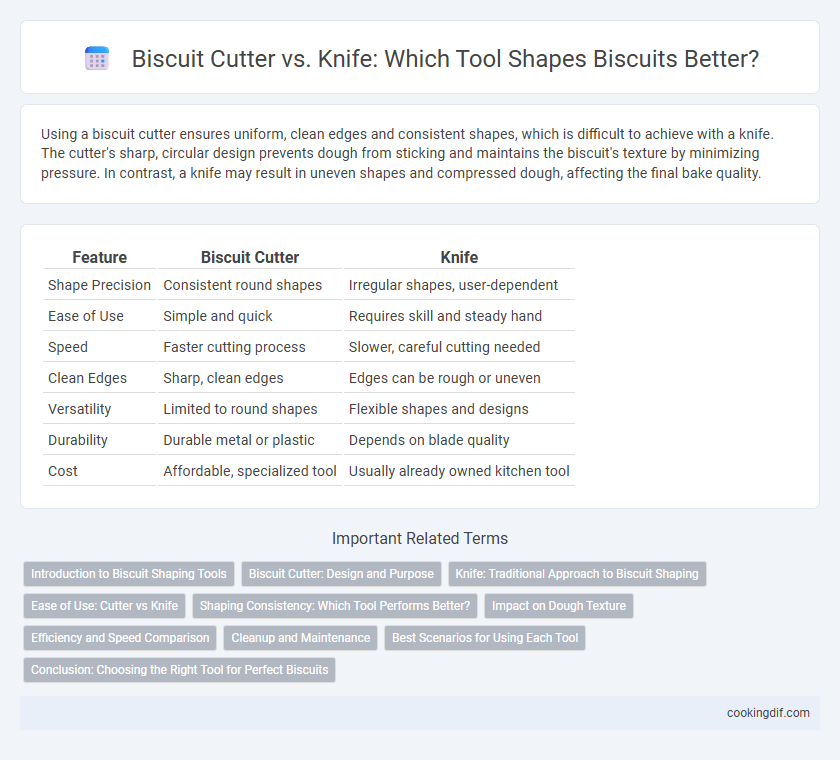Using a biscuit cutter ensures uniform, clean edges and consistent shapes, which is difficult to achieve with a knife. The cutter's sharp, circular design prevents dough from sticking and maintains the biscuit's texture by minimizing pressure. In contrast, a knife may result in uneven shapes and compressed dough, affecting the final bake quality.
Table of Comparison
| Feature | Biscuit Cutter | Knife |
|---|---|---|
| Shape Precision | Consistent round shapes | Irregular shapes, user-dependent |
| Ease of Use | Simple and quick | Requires skill and steady hand |
| Speed | Faster cutting process | Slower, careful cutting needed |
| Clean Edges | Sharp, clean edges | Edges can be rough or uneven |
| Versatility | Limited to round shapes | Flexible shapes and designs |
| Durability | Durable metal or plastic | Depends on blade quality |
| Cost | Affordable, specialized tool | Usually already owned kitchen tool |
Introduction to Biscuit Shaping Tools
Biscuit cutters, typically made from stainless steel with a sharp circular edge, provide consistent, uniform shapes essential for even baking and aesthetic appeal. In contrast, knives require more skill to shape dough properly but allow for customizable sizes and shapes, offering versatility for creative recipes. Choosing the right biscuit shaping tool affects dough handling, baking results, and final texture, making the cutter ideal for precision and the knife suitable for flexibility.
Biscuit Cutter: Design and Purpose
Biscuit cutters are specifically designed with sharp, circular edges to create uniform, perfectly shaped biscuits, ensuring even baking and consistent texture. Unlike knives, biscuit cutters maintain the dough's layering, which is crucial for achieving flaky, tender results. Their purpose-built design minimizes dough deformation, promoting optimal rise and appearance during baking.
Knife: Traditional Approach to Biscuit Shaping
Using a knife for shaping biscuits offers precise control over the dough's thickness and edge sharpness, preserving the traditional handcrafted quality favored by bakers. Unlike biscuit cutters that create uniform shapes, a knife allows for creative freedom in shaping and customizing biscuit sizes, which can influence baking consistency and texture. The manual cutting process with a knife also reduces dough waste by facilitating tailored cuts around irregular dough portions.
Ease of Use: Cutter vs Knife
Biscuit cutters offer superior ease of use compared to knives by providing consistent, clean shapes with minimal effort, reducing dough handling time. Knives require more skill and precision to achieve uniform biscuits, often resulting in uneven edges and longer preparation. Using a biscuit cutter ensures faster, more reliable shaping, ideal for both novice and experienced bakers.
Shaping Consistency: Which Tool Performs Better?
Biscuit cutters deliver consistent, uniform shapes due to their precise circular design, ensuring each biscuit rises evenly during baking. Knives, while versatile, often produce irregular edges and inconsistent thicknesses that can affect baking outcomes. For consistent shaping and professional presentation, biscuit cutters outperform knives in achieving uniformity.
Impact on Dough Texture
Biscuit cutters create clean, even edges that help maintain consistent dough layers, resulting in a flakier, more tender biscuit texture. Using a knife to shape dough can crush or compress the layers, leading to denser biscuits with less rise. Proper biscuit cutting with a dedicated cutter preserves the dough's integrity and enhances the final crumb structure.
Efficiency and Speed Comparison
Biscuit cutters provide consistent, uniform shapes that speed up the dough-cutting process, reducing preparation time compared to using a knife, which requires more skill to achieve even shapes. The sharp edge and defined diameter of a biscuit cutter ensure quicker and cleaner cuts, minimizing dough waste and maintaining the integrity of the biscuit's texture. Using a knife often results in uneven edges and slower shaping, making biscuit cutters a more efficient tool for high-volume baking.
Cleanup and Maintenance
Biscuit cutters feature smooth edges and simple shapes that make cleanup faster and less labor-intensive compared to knives, which often have intricate designs or straight blades that can trap dough residue. Biscuit cutters are typically dishwasher-safe or easily washed by hand without risk of dulling, while knives require careful cleaning and sharpening to maintain their cutting ability. Using a biscuit cutter minimizes maintenance time and ensures consistent shaping without frequent blade maintenance.
Best Scenarios for Using Each Tool
Biscuit cutters provide precise, uniform shapes ideal for consistent baking results, especially when making traditional round biscuits or scones. Knives offer flexibility in shaping irregular or custom sizes, perfect for creative or rustic baked goods where exact shapes are less critical. Using a biscuit cutter is best for professional presentation, while a knife suits casual or experimental baking scenarios.
Conclusion: Choosing the Right Tool for Perfect Biscuits
Biscuit cutters create consistent, clean edges that promote even rising and uniform baking, essential for achieving the ideal flaky texture. Knives can shape biscuits but often compress dough, leading to denser results and uneven cooking. For perfectly shaped biscuits with optimal fluffiness, a biscuit cutter is the superior tool choice.
Biscuit cutter vs knife for shaping Infographic

 cookingdif.com
cookingdif.com